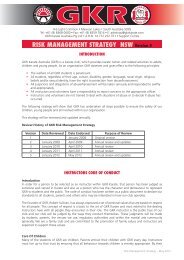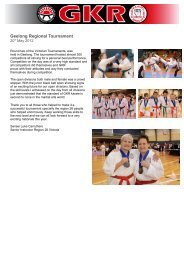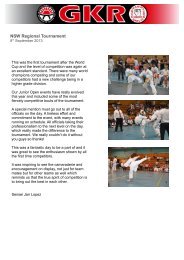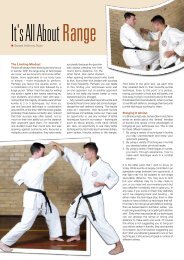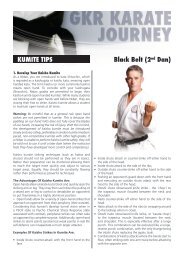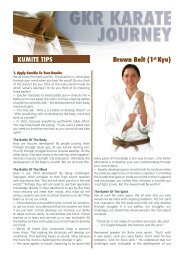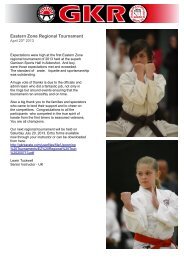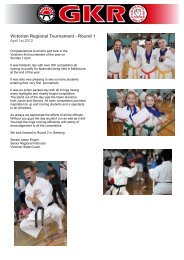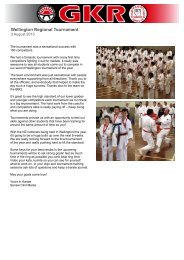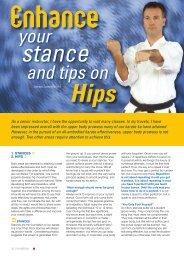Red Belt (4th Kyu) KumiTe TipS - GKR Karate
Red Belt (4th Kyu) KumiTe TipS - GKR Karate
Red Belt (4th Kyu) KumiTe TipS - GKR Karate
Create successful ePaper yourself
Turn your PDF publications into a flip-book with our unique Google optimized e-Paper software.
your breathing will play a large role in helping you to relax<br />
more during not only kumite, but also your kihon and<br />
kata.<br />
» Now that at <strong>Red</strong> belt our primary goal is to refine<br />
everything we know, and embed it in our instinctive<br />
subconscious, we have room in our mind to really work on<br />
relaxing our body.<br />
» If you are not aware of the benefits of being relaxed in<br />
your karate; there are many:<br />
Energy conservation: Enormous amounts of energy are<br />
wasted because muscles hold excess tension. Students<br />
will often say, “I’m not fit enough.” But the real culprit is<br />
not their fitness, but rather the excess energy lost through<br />
excess tension.<br />
Speed: Tension in the body is like driving a car with the<br />
hand brake on. Learning to relax will allow your muscles to<br />
move at full speed.<br />
Power: Power comes from the combination of both mass<br />
(weight) and velocity (speed). If you can move faster you<br />
can strike harder. What’s more, excess tension prevents the<br />
small movements that are required for extra power (such<br />
as hip rotation) from taking place.<br />
» Having achieved a fairly sound level of mastery over your<br />
body, you can start to develop your RTBP (your relax tense<br />
balance point).<br />
So what is your RTBP?<br />
You have probably been told to relax a hundred times or<br />
more during your karate. But you can’t completely relax.<br />
If you did you would literally fall over! How can you hold<br />
your guard up if you are completely relaxed, would your<br />
arms not swing by your sides?<br />
» This is where your RTBP comes into play. It’s developing<br />
an understanding of each muscle and how much tension<br />
actually needs to hold. In essence, you need just enough<br />
tension to hold form. Any less tension and you lose form,<br />
any more tension and you will lose speed and power.<br />
The RTBP Test<br />
A good test to develop your RTBP is to do a few push ups<br />
(press ups). Get into position and tighten every muscle you<br />
can think of (your feet, calves, hamstrings, quads, abs,<br />
back, arms, neck, face etc). Tighten every single muscle as<br />
tight as you possibly can and then maintain 100% tension<br />
while performing 2 or 3 push ups. You will find it not only<br />
exhausting but extremely difficult to do. This is obviously<br />
an example of excess tension to the extreme.<br />
» Next relax every single muscle to 100% relaxation. Ok,<br />
now it’s impossible to get off the floor.<br />
» So therefore somewhere between full tension of every<br />
muscle, and no tension in any muscle, there is a balance<br />
point. For the push up example, you can work out which<br />
muscles you need tensed, and which need no, or little<br />
tension, to get the job done.<br />
Do I Ever Need 100%?<br />
It’s often said, at the very end of a technique, when you<br />
apply full kime that you need to tense up every muscle as<br />
hard as you can for a milli-second. For lower grades this is<br />
probably quite accurate because if they don’t tense up they<br />
are likely to injure themselves.<br />
» As you progress through your karate journey you will<br />
come to realise that you never need 100% tension. Not<br />
even in your fist. You will actually be able to hit harder than<br />
you ever have while remaining quite relaxed - even at the<br />
point of impact. This is not something for you to develop<br />
right now, its something to look forward to in the future.<br />
Right now, just look to remove excess tension in every area<br />
outside of impact in our karate.<br />
5. Implement Kata Senjutsu Into Kumite<br />
Kumite is a physical expression of your karate. It allows you<br />
to demonstrate your knowledge of technique and senjutsu<br />
(strategy).<br />
Taigyoku Kumite: While you may not be an expert, a <strong>Red</strong><br />
belt should be able to demonstrate the principles of the<br />
Taigyoku kata in their kumite.<br />
Saifa Kumite: With different types of movement and<br />
principles, a <strong>Red</strong> belt should be able to demonstrate to<br />
some degree, Saifa in their kumite.<br />
Bassai-dai Kumite: We did not recommend that you<br />
work on implementing Bassai-dai into your kumite at Blue<br />
belt. This would have given you too much to think about;<br />
especially seeing Bassai-dai was not instinctive to you.<br />
» Being <strong>Red</strong> belt does mean that you know Bassai-dai quite<br />
well and that you can start to think about implementing<br />
it into your kumite. This will not only develop your<br />
understanding of the kata, it will actually help your kata<br />
performance because you will be using your body in a<br />
similar way to the kata.<br />
Examples of using Bassai-dai in kumite are:<br />
a) Quality hip movement. During Bassai-dai we execute<br />
large and powerful hip rotations when we execute renuke<br />
(two blocks with alternate arms). In kumite it is a<br />
great idea to start really focusing on this hip movement<br />
when executing ren tsuki (two arms striking alternatively,<br />
for example, lunge punch followed by reverse punch).<br />
» Some students get to <strong>Red</strong> belt and they still hardly<br />
use their hips in their kumite. This shows that they are<br />
neglecting the important lessons in their kata. Quality<br />
hip movement should also occur when you execute<br />
single reverse punches and counter-strikes. One can<br />
easily see how working on the sharp, twisting of the<br />
hips in kumite will come back and help their kata.<br />
b) Maintaining deep, well-grounded stances while<br />
defending. Bassai-dai promotes this principle. To see<br />
<strong>Red</strong> belts forever running away when defending shows<br />
they are not thinking about the skills their kata is trying<br />
to instil in them. Of course there are times to flee, but<br />
there should be times where you adopt a well-grounded<br />
last stand.



